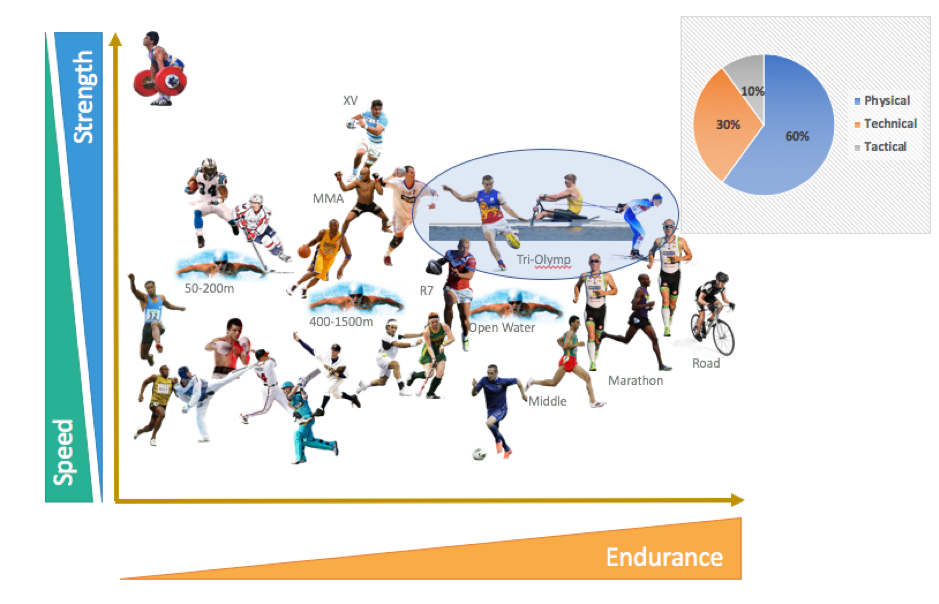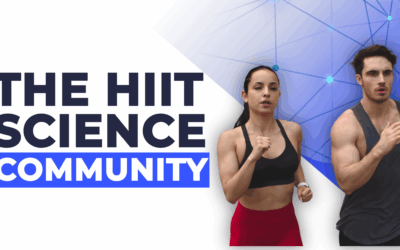
Figure 1. The context we can use to understand the performance requirements of rowing and subsequent need for HIIT.
The study
To achieve this, a group of 13 highly-trained rowers (Figure 2) each performed three different training sessions on a rowing ergometer on separate weeks as follows:- 5 x 10 min, 4 min rest (threshold session)
- 5 x 3.5 min, 4 min rest (long interval HIIT)
- 10 x 30 s, 5 min rest (sprint interval training)

Figure 2. Our rowers performing HIIT.
| Threshold Session | Long Interval HIIT | Sprint Interval Training | |
| % VO2peak power | 79.6 ± 6.8 | 97.0 ± 5.4 | 156.4 ± 15.6 |
| TRIMP | 16.7 ± 7.9 | 10.6 ± 0.4 | 12.1 ± 1.3 |
| sRPE | 18.3 ± 0.9 | 19.0 ± 0.7 | 16.2 ± 1.7 |
| Blood lactate (mmol·L-1) | 8.2 ± 2.9 | 11.6 ± 2.5 | 11.8 ± 3.8 |
| Time >90% HRmax (min) | 30.5 ± 11.8 | 14.8 ± 2.1 | 2.7 ± 3.6 |
| Time 80-90% HRmax (min) | 18.1 ± 9.7 | 7.6 ± 3.7 | 7.2 ± 2.0 |
What we found
As shown in Figure 3, there were no statistically clear differences in HRV recovery time between any of the sessions, but recovery times for HRV following the HIIT sessions were faster than the > 48 h duration reported in other studies (11). Interestingly, HRV took the longest absolute time to return to pre-HIIT levels following the 5 x 10 min threshold session, which occurred after 29 ± 12 h (mean ± SD). Time for HRV recovery from the 5 x 3.5 min long interval and 10 x 30 s sprint training sessions took 16 ± 11 and 18 ± 10 h, respectively.
Figure 3. Percentage change in heart rate variability (HRV) from immediately prior (baseline; -1 h) to each high-intensity interval training (HIIT) session performed and throughout the following 72 h. The graph illustrates the post-exercise suppression of cardiac parasympathetic activity and its return to pre-HIIT levels.

Figure 4. Recovery time (mean +/- SD) of heart rate variability (HRV), HRV following 5 min of submaximal rowing (HRVrec), submaximal rowing heart rate (HRex), heart rate recovery (HRR), 30 s maximal rowing peak and mean power following three different high-intensity interval training sessions on the rowing ergometer. Individual data points (white circles and dashed lines) show the variability in recovery responses between rowers.
What it means
Research comparing HIIT recovery time to that of low-intensity has consistently shown longer recovery times following higher intensity sessions (4,5). Given the 5 x 10 min threshold session was performed at a lower intensity (17 and 76 percentage points of VO2max lower than the 5 x 3.5 min long interval and 10 x 30 s sprint interval sessions, respectively), with greater time spent at high heart rates (Table 1), these results suggest to us that recovery time following training can also be influenced substantially by the duration of time spent at moderate and high intensities, and not just simply the absolute intensity of the training session itself. Nevertheless, recovery durations we observed following the different HIIT sessions performed in this study do not necessarily conform with a 48 h separation recommendation between all types of HIIT sessions. We saw that even when training is continued throughout the post-HIIT recovery period, the time taken to recover to a pre-HIIT state can occur anywhere between 6-38 h depending on the HIIT session, the individual, and recovery measure assessed (Figure 4). This highlights a crucial point:“If we truly want to optimize the recovery duration between HIIT, we must consider the individual”.
Another important outcome of our study was that recovery time following HIIT seemed to depend on the measure we assessed. Our findings indicate that the recovery of performance occurs before the recovery of cardiac parasympathetic activity. Indeed, perceived recovery did not return to pre-HIIT levels during the 72-h measurement period. As regular training was continued throughout the 72 h period assessed (to replicate a real-world training environment), and the first programmed rest day occurred after the 72 h measurement period, the accumulation of training load throughout this period may explain why perceived recovery remained elevated, as psychometric measures have been shown to be more sensitive to training load than physiological assessments (9). With this in mind, we believe it is important to not only assess performance but also cardiac parasympathetic activity and wellness measures when assessing recovery and readiness-to-train, as the short-term return of performance does not necessarily mean an athlete has completely recovered. This is particularly important in programming considerations, as the repeated performance of threshold and HIIT sessions without appropriate recovery may lead to the continuous suppression of cardiac parasympathetic activity and reduced physical performance (7).Key practical outcomes:
- Recovery from HIIT does not always require 48 h, so subsequent HIIT can be programmed earlier depending on the recovery status of the individual.
- Both long duration moderate to high-intensity threshold sessions, as well as long interval HIIT and SIT, were equally taxing from a recovery standpoint.
- A combination of performance, cardiac parasympathetic (i.e., HR), and perceptual/wellness measures are recommended monitoring variables that can be used to assess recovery from HIIT.
- An individualised approach to assessing recovery is advised, given the numerous factors that influence recovery and wide variation shown between individual athlete recovery time to HIIT
- Buchheit, M and Laursen, PB. High-intensity interval training, solutions to the programming puzzle. Part II: Anaerobic energy, neuromuscular load and practical applications. Sport Med 43: 927–954, 2013.
- Hautala, A, Tulppo, MP, Makikallio, TH, Laukkanen, R, Nissila, S, and Huikuri, H V. Changes in cardiac autonomic regulation after prolonged maximal exercise. Clin Physiol 21: 238–245, 2001.Available from: http://doi.wiley.com/10.1046/j.1365-2281.2001.00309.x
- Holt, AC, Plews, DJ, Oberlin-Brown, K, Merien, F, and Kilding, AE. Cardiac parasympathetic and anaerobic performance recovery after high-intensity exercise in rowers. Int J Sports Physiol Perform 1–26, 2018.Available from: https://journals.humankinetics.com/doi/abs/10.1123/ijspp.2018-0200
- Mourot, L, Bouhaddi, M, Tordi, N, Rouillon, JD, and Regnard, J. Short- and long-term effects of a single bout of exercise on heart rate variability: Comparison between constant and interval training exercises. Eur J Appl Physiol 92: 508–517, 2004.
- Niewiadomski, W, Gasiorowska, A, Krauss, B, Mróz, A, and Cybulski, G. Suppression of heart rate variability after supramaximal exertion. Clin Physiol Funct Imaging 27: 309–319, 2007.
- Perna, FM and McDowell, SL. Role of psychological stress in cortisol recovery from exhaustive exercise among elite athletes. Int J Behav Med 2: 13–26, 1995.
- Plews, DJ, Laursen, PB, Kilding, AE, and Buchheit, M. Heart rate variability in elite triathletes, is variation in variability the key to effective training A case comparison. Eur J Appl Physiol 112: 3729–3741, 2012.
- Samuels, C. Sleep, recovery, and performance: the new frontier in high- performance athletics. Phys Med Rehabil Clin N Am 20: 149–159, 2009.
- Saw, AE, Main, LC, and Gastin, PB. Monitoring the athlete training response: subjective self-reported measures trump commonly used objective measures: a systematic review. Br J Sport Med 0: 1–13, 2015.
- Seiler, S, Haugen, O, and Kuffel, E. Autonomic recovery after exercise in trained athletes: Intensity and duration effects. Med Sci Sports Exerc 39: 1366–1373, 2007.
- Stanley, J, Peake, JM, and Buchheit, M. Cardiac parasympathetic reactivation following exercise: implications for training prescription. Sport Med 43: 1259–1277, 2013.






